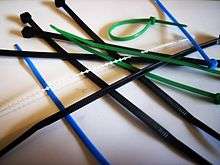Cable tie
A cable tie (also known as a hose tie, zip tie, or by the brand name Ty-Rap) is a type of fastener, for holding items together, primarily electrical cables or wires. Because of their low cost and ease of use, cable ties are ubiquitous, finding use in a wide range of other applications.

The common cable tie, normally made of nylon, has a flexible tape section with teeth that engage with a pawl in the head to form a ratchet so that as the free end of the tape section is pulled the cable tie tightens and does not come undone. Some ties include a tab that can be depressed to release the ratchet so that the tie can be loosened or removed, and possibly reused. Stainless steel versions, either naked or coated with a rugged plastic, cater for exterior applications and hazardous environments.[1]
Design and use

The most common cable tie consists of a flexible nylon tape with an integrated gear rack, and on one end a ratchet within a small open case. Once the pointed tip of the cable tie has been pulled through the case and past the ratchet, it is prevented from being pulled back; the resulting loop may only be pulled tighter. This allows several cables to be bound together into a cable bundle and/or to form a cable tree.
A cable tie tensioning device or tool may be used to apply a cable tie with a specific degree of tension. The tool may cut off the extra tail flush with the head in order to avoid a sharp edge which might otherwise cause injury.
In order to increase resistance to ultraviolet light in outdoor applications, nylon containing a minimum of 2% carbon black is used to protect the polymer chains and extend the cable tie's service life. Blue cable ties are supplied to the food industry and contain a metal additive so they can be detected by industrial metal detectors.[2] Cable ties made of ETFE (Tefzel) are used in radiation-rich environments. Red cable ties made of ECTFE (Halar) are used for plenum cabling.
Stainless steel cable ties are also available for flameproof applications—coated stainless ties are available to prevent galvanic attack from dissimilar metals (e.g. zinc-coated cable tray).[1]
PlastiCuffs are handcuffs based on the cable tie design and are used by law enforcement to restrain prisoners.[3] Cable ties are also sometimes used to prevent hubcaps (also known as wheel trims) from falling off a moving vehicle, and some are sold specifically for this purpose.
History
Cable ties were first invented by Thomas & Betts, an electrical company, in 1958 under the brand name Ty-Rap. Initially they were designed for airplane wire harnesses. The original design used a metal tooth, and these can still be obtained. Manufacturers later changed to the nylon/plastic design.[4]
Over the years the design has been extended and developed into numerous spin-off products. One example was a self-locking loop developed as an alternative to purse-string suture in colon anastomosis.[5]
Ty-Rap cable tie inventor, Maurus C. Logan, worked for Thomas & Betts and finished his career with the company as Vice President of Research and Development. During his tenure at Thomas & Betts, he contributed to the development and marketing of many successful Thomas & Betts products. Logan died on 12 November 2007, at the age of 86.[6]
The idea of the cable tie came to Logan while touring a Boeing aircraft manufacturing facility in 1956. Aircraft wiring was a cumbersome and detailed undertaking, involving thousands of feet of wire organized on sheets of 50-foot-long plywood and held in place with knotted, waxcoated, braided nylon cord. Each knot had to be pulled tight by wrapping the cord around one's finger which sometimes cut the operator's fingers until they developed thick calluses or "hamburger hands." Logan was convinced there had to be an easier, more forgiving, way to accomplish this critical task.
For the next couple of years, Logan experimented with various tools and materials. On June 24, 1958, a patent for the Ty-Rap cable tie was submitted.[7]
Surgery
Self-locking loops are used for closure of the sternum after open chest surgery [8][9] and at repair of rib fractures in foals.[10]
Within research, there are self-locking loops, based on the construction of the traditional cable tie, designed for surgery. The device is intended for ligation purposes, by compressing tissue hemorrhage is prevented. The same material is used as in surgical suture (resorbable polymers), therefore the implant can be left in the body where after the material is resorbed by the tissue.[11][12][13][14][15]
Traditional cable ties, due to their non-resorbable material, may not be left in the body permanently due to the risk of development of chronic granulomas.[16][17] In urology, short term use of cable ties have been described at partial kidney resection.[18][19][20]
Reuse
Cable ties are generally single-use devices. Some models have a button to release the pawl and allow re-use.
Types of specialty cable ties
- Beaded cable ties: Beaded design allows them to be releasable and reusable
- Releasable cable ties: Reusable cable ties with a releasable ratchet
- Ladder style cable ties: For intermediate bundling and retail applications
- Identification cable ties: Built-in flags for written or printed identification
- Parallel entry cable ties: Tamper-proof, low profile heads
- Tear-off cable ties: Quick release design requires no cutting tools
- Pull-tight seals: Tamper-evident seals
- Steggel ties: Heavy duty, multipurpose ties
Alternatives
Other methods of bundling cable together securely and semi-permanently include cable lacing, strapping, binding knots such as the surgeon's knot or constrictor knot, Velcro brand hook-and-loop strips, conveyor belt hooks, twist ties, Rapstrap fasteners, or metal buckle.
See also
References
- "Stainless steel cable ties" (PDF). Thomas & Betts.
- Dodds, Chris on (15 November 2013). "Detectable Cable Ties for Food Industry". cablejoints.co.uk. Retrieved 14 July 2017.
- Meissner, Craig (December 1, 2002). "Ties That Bind". Police Magazine.
- See the Thomas and Betts official website. Archived November 4, 2013, at the Wayback Machine
- Höglund, Odd V.; Maxon, Oskar; Grönberg, Anders (8 February 2017). "A self-locking loop as an alternative to purse-string suture in colon anastomosis: a feasibility study". BMC Research Notes. 10 (1). doi:10.1186/s13104-017-2412-4. PMC 5299739. PMID 28179015.
- "Maurus C. Logan Obituary".
- Maurus C. Logan, "Cable bundling and supporting strap",U.S. Patent 3,022,557, filed 24 June 1958, issued 27 February 1962.
- "Sterna-Band Sutures for Closure of Median Sternotomies and Lateral Thoracotomies". www.sternaband.com.
- Grapow, Martin TR; Melly, Ludovic F; Eckstein, Friedrich S; Reuthebuch, Oliver T (25 June 2012). "A new cable-tie based sternal closure system: description of the device, technique of implantation and first clinical evaluation". Journal of Cardiothoracic Surgery. 7 (1). doi:10.1186/1749-8090-7-59. PMC 3408342. PMID 22731778.
- Downs, C; Rodgerson, D (March 2011). "The use of nylon cable ties to repair rib fractures in neonatal foals". The Canadian Veterinary Journal. 52 (3): 307–9. PMC 3039906. PMID 21629427.
- da Mota Costa, Matheus Roberto; de Abreu Oliveira, André Lacerda; Ramos, Renato Moran; de Moura Vidal, Leonardo Waldstein; Borg, Niklas; Höglund, Odd V. (1 January 2016). "Ligation of the mesovarium in dogs with a self-locking implant of a resorbable polyglycolic based co-polymer: a study of feasibility and comparison to suture ligation". BMC Research Notes. 9: 245. doi:10.1186/s13104-016-2042-2. ISSN 1756-0500. PMC 4848858. PMID 27121033.
- Höglund, Odd V.; Ingman, Jessica; Södersten, Fredrik; Hansson, Kerstin; Borg, Niklas; Lagerstedt, Anne-Sofie (1 January 2014). "Ligation of the spermatic cord in dogs with a self-locking device of a resorbable polyglycolic based co-polymer – feasibility and long-term follow-up study". BMC Research Notes. 7: 825. doi:10.1186/1756-0500-7-825. ISSN 1756-0500. PMC 4247741. PMID 25410023.
- Höglund, Odd Viking (2012). A resorbable device for ligation of blood vessels : development, assessment of surgical procedures and clinical evaluation (PDF). Acta Universitatis agriculturae Sueciae. pp. 1–73. ISBN 978-91-576-7686-3.
- Guedes, Rogério Luizari; Höglund, Odd Viking; Brum, Juliana Sperotto; Borg, Niklas; Dornbusch, Peterson Triches (3 January 2018). "Resorbable Self-Locking Implant for Lung Lobectomy Through Video-Assisted Thoracoscopic Surgery: First Live Animal Application". Surgical Innovation. 25: 155335061775129. doi:10.1177/1553350617751293. PMID 29298608.
- da Mota Costa, Matheus Roberto; de Abreu Oliveira, André Lacerda; de Moura Vidal, Leonardo Waldstein; Moran Ramos, Renato; de Oliveira Campos, Ingrid; Hansson, Kerstin; Ley, Charles J; Olsson, Ulf; Borg, Niklas Olov; Höglund, Odd Viking (13 April 2019). "Comparison of macroscopic resorption time for a self-locking device and suture material in ovarian pedicle ligation in dogs". Veterinary Record. 184 (15): 478–478. doi:10.1136/vr.104732.
- Werner, RE; Straughan, AJ; Vezin, D (1 January 1992). "Nylon cable band reactions in ovariohysterectomized bitches". Journal of the American Veterinary Medical Association. 200 (1): 64–6. PMID 1537693.
- Johnson-Neitman, JL; Bahr, RJ; Broaddus, KD (2005). "Fistula formation secondary to a nylon cable band in a dog". Veterinary Radiology & Ultrasound. 47 (4): 355–7. doi:10.1111/j.1740-8261.2006.00153.x. PMID 16863053.
- Cadeddu, JA; Corwin, TS; Traxer, O; Collick, C; Saboorian, HH; Pearle, MS (March 2001). "Hemostatic laparoscopic partial nephrectomy: cable-tie compression". Urology. 57 (3): 562–6. doi:10.1016/s0090-4295(00)01009-8. PMID 11248648.
- Mcdougall, Elspeth M.; Clayman, Ralph V.; Chandhoke, Paramjit S.; Kerbl, Kurt; Stone, A. Marika; Wick, Mark R.; Hicks, Marshall; Figenshau, Robert S. (June 1993). "Laparoscopic Partial Nephrectomy in the Pig Model". Journal of Urology. 149 (6): 1633–1636. doi:10.1016/s0022-5347(17)36465-0.
- Winfield, Howard N.; Donovan, James F.; Lund, Greg O.; Kreder, Karl J.; Stanley, Kenneth E.; Brown, Bruce P.; Loening, Stefan A.; Clayman, Ralph V. (May 1995). "Laparoscopic Partial Nephrectomy: Initial Experience and Comparison to the Open Surgical Approach". Journal of Urology. 153 (5): 1409–1414. doi:10.1016/s0022-5347(01)67415-9.